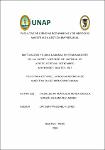| dc.contributor.advisor | Pasquel Flores, Beny | |
| dc.contributor.author | Caballero Reátegui, Perla Gacela | |
| dc.contributor.author | Gonzales Ramírez, Abner | |
| dc.date.accessioned | 2018-09-01T17:18:32Z | |
| dc.date.available | 2018-09-01T17:18:32Z | |
| dc.date.issued | 2018 | |
| dc.identifier.uri | http://repositorio.unapiquitos.edu.pe/handle/20.500.12737/5583 | |
| dc.description.abstract | El objetivo fue determinar la asociación entre la motivación y el clima laboral en trabajadores de la Corte Superior de Justicia de Loreto de la ciudad de Iquitos, Período Setiembre - Noviembre del 2017. El método empleado fue el cuantitativo y el diseño no experimental de tipo correlacional y transversal. La Población estuvo conformada por 436 trabajadores entre magistrados y personal a plazo fijo, suplentes, temporales, a plazo indeterminado, CAS y empleados por convenio de la Corte Superior de Justicia de Loreto de la ciudad de Iquitos, y la muestra estuvo conformada 204 trabajadores con las mismas características de la población. La técnica fue la encuesta con auto reporte, y los instrumentos fueron dos escalas: para Motivación toma de decisiones (Validez 0,89 y confiabilidad 0,87, y para el Clima laboral (Validez 0,87 y confiabilidad 0,84). Los datos fueron analizados con el SPSS versión 22.0. La prueba estadística inferencial fue el Coeficiente de Contingencia, con α =0.05 y nivel de confianza de 95%. Resultados: En Nivel de motivación 89,7%(183) tuvieron motivación alta, en clima laboral 49,5% (101) manifestaron clima laboral medio, 24% (49) clima laboral favorable, mientras que 20,1% (41) clima laboral desfavorable, al aplicar la prueba estadística No Paramétrica Coeficiente de Contingencia se obtuvo CC = 0,101, gl = 4 p=0,102 para α = 0,05. Se obtuvo resultados no significativos (p= 0,102 > 0,05), lo cual permitieron aceptar la hipótesis general nula: “No Existe asociación estadística significativa entre la motivación y el clima laboral en trabajadores de la Corte Superior de Justicia de Loreto de la ciudad de Iquitos”. Conclusión: Al no existir asociación significativa entre estas dos variables, se podría indicar que los trabajadores consiguen sus motivaciones de manera intrínseca, ya que se forman profesionalmente con sus propios recursos, sobresalen de manera personal y estas motivaciones no forman parte de la gestión, por cuanto no consiguen desarrollar sus funciones en un clima laboral favorable. | es_PE |
| dc.description.abstract | The objective was to determine the association between motivation and work environment in workers of the Superior Court of Justice of Loreto in the city of Iquitos, Period September - November 2017. The method used was the quantitative and non-experimental design of type correlational and transversal. The population consisted of 436 workers between magistrates and fixed-term staff, alternates, temporary, indeterminate term, CAS and employees by agreement of the Superior Court of Justice of Loreto of the city of Iquitos, and the sample consisted of 204 workers with the same characteristics of the population. The technique was the survey with self-report, and the instruments were two scales: for Motivation decision making (Validity 0.89 and reliability 0.87, and for Labor Climate (Validity 0.87 and reliability 0.84). Data were analyzed with the SPSS version 22.0.The inferential statistical test was the Contingency Coefficient, with α = 0.05 and confidence level of 95% Results: In Level of motivation 89.7% (183) were highly motivated, in climate labor 49.5% (101) showed average working climate, 24% (49) favorable working environment, while 20.1% (41) unfavorable working climate, when applying the statistical test No Parametric Contingency Coefficient was obtained CC = 0.101 , gl = 4 p = 0.102 for α = 0.05 Non-significant results were obtained (p = 0.102> 0.05), which allowed accepting the null general hypothesis: "No significant statistical association between motivation and climate work in workers of the Superior Court of Justice of L Orto of the city of Iquitos ". Conclusion: As there is no significant association between these two variables, it could be indicated that workers achieve their motivations in an intrinsic way, since they are trained professionally with their own resources, excel personally and these motivations are not part of the management, how much they fail to develop their functions in a favorable work environment. | en_US |
| dc.description.uri | Tesis | es_PE |
| dc.format | application/pdf | es_PE |
| dc.language.iso | spa | es_PE |
| dc.publisher | Universidad de la Amazonía Peruana | es_PE |
| dc.rights | info:eu-repo/semantics/openAccess | es_PE |
| dc.rights | Attribution-NonCommercial-NoDerivs 3.0 United States | * |
| dc.rights.uri | http://creativecommons.org/licenses/by-nc-nd/3.0/us/ | * |
| dc.source | Universidad Nacional de la Amazonía Peruana | es_PE |
| dc.source | Repositorio institucional - UNAP | es_PE |
| dc.subject | Ambiente de trabajo | es_PE |
| dc.subject | Motivaciones | es_PE |
| dc.subject | Corte suprema de justicia | es_PE |
| dc.subject | Trabajadores | es_PE |
| dc.title | Motivación y clima laboral en trabajadores de la corte superior de justicia de Loreto período setiembre – noviembre Iquitos 2017 | es_PE |
| dc.type | info:eu-repo/semantics/masterThesis | es_PE |
| thesis.degree.discipline | Ciencias Económicas y de Negocios | es_PE |
| thesis.degree.grantor | Universidad Nacional de la Amazonía Peruana. Escuela de Posgrado | es_PE |
| thesis.degree.level | Maestría | es_PE |
| thesis.degree.name | Magister en Gestión Empresarial | es_PE |
| thesis.degree.program | Regular | es_PE |
| dc.subject.ocde | Administración Pública | es_PE |
| dc.subject.ocde | http://purl.org/pe-repo/ocde/ford#5.06.02 | es_PE |


